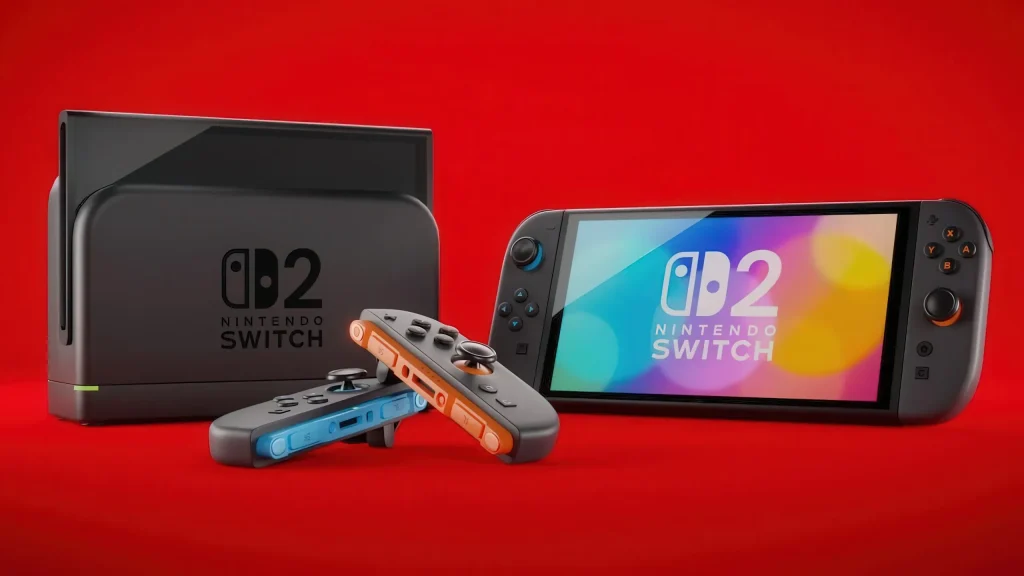Nintendo Switch 2 sales have rocked the gaming world as the company reported over 5.82 million units sold in just the first month following its launch. This impressive figure has contributed greatly to Nintendo’s revenue growth, allowing the company to more than double its revenue in the first fiscal quarter. With a staggering operating profit of 56.9 billion yen, Nintendo’s Switch 2 sales performance has significantly outshone market expectations, surpassing estimates for both revenue and sales from its dedicated gaming platform. Analysts are optimistic about the Nintendo fiscal quarter results, indicating that the new hybrid console has revitalized interest in Nintendo products and gaming overall. As the demand for gaming consoles continues to surge, the Nintendo Switch 2 is positioned as a strong contender in the competitive gaming market, paving the way for sustained growth and innovation.
The recent surge in sales of the latest Nintendo console, often referred to as the Switch 2, reflects the company’s strategic efforts to revitalize its gaming platform offerings. Following its highly anticipated debut, the hybrid console has captured avid gamers’ attention, showcasing Nintendo’s ability to adapt to the changing landscape of video gaming. With its launch performance exceeding all expectations, analysts are keenly observing the implications for Nintendo’s overall fiscal results, particularly as they relate to market dynamics. This analysis touches on how the strong sales numbers align with broader trends in the gaming industry, potentially influencing Nintendo’s revenue outlook moving forward. As the excitement builds around the innovative features of the Switch 2, stakeholders are eagerly awaiting more insights into Nintendo’s ongoing initiatives and future plans in the gaming market.
Nintendo Switch 2 Launch: A Record-Breaking Start
The launch of the Nintendo Switch 2 on June 5 has made a significant impact on the gaming market, boasting sales of over 3.5 million units within just four days. This extraordinary achievement marks one of the most successful console launches in Nintendo’s history, showcasing the anticipation and demand built up for the latest iteration of their hybrid console. With features and improvements designed to enhance gameplay experiences, the Switch 2 not only appealed to existing fans but also attracted new gamers eager to explore what the new device has to offer.
Beyond the initial excitement, the Nintendo Switch 2 launch has indelibly altered the landscape of the gaming market. Analysts suggest that the performance during the launch window could be indicative of long-term sales trajectory, especially as Nintendo aims to sell 15 million units by the end of the current fiscal year. This target, although deemed conservative by some, reflects Nintendo’s strategic focus on expanding its user base and leveraging the Switch 2’s enhanced capabilities to penetrate deeper into the global gaming market.
Nintendo Switch 2 Sales Performance Over the Fiscal Quarter
In its first fiscal quarter, Nintendo reported sales of the Switch 2 reaching 5.82 million units, contributing to a staggering 132% year-over-year increase in revenue, totaling 572.3 billion Japanese yen. This remarkable growth demonstrates not only the popularity of the new console but also illustrates how effectively Nintendo has pivoted to meet consumer demands with innovative product offerings. The Switch 2’s success is attributed to its upgraded features and a higher price point, which provided a new revenue stream compared to its predecessor.
During this period, the dedicated video game platform business experienced a remarkable growth of 142.5% year-over-year, underscoring the Switch 2’s impact on Nintendo’s fiscal performance. However, it’s important to note that other business areas, such as the entertainment segment related to its intellectual properties, saw a decline in revenue. Nevertheless, the overall sales performance of the Switch 2 displays Nintendo’s resilience and ability to capitalize on its leading position within the gaming industry.
Nintendo’s Revenue Growth and Financial Stability
Nintendo’s financial reports reflect strong growth, driven significantly by the Switch 2’s impressive sales performance. In the recent fiscal quarter, not only did revenue surpass analysts’ expectations, but the company also maintained its fiscal projections for the year, signaling confidence in their operational strategy. The robust operating profit of 56.9 billion yen further illustrates the company’s sound financial management, even amidst fluctuations in other revenue areas.
Continued revenue growth is critical for Nintendo as it works to solidify its competitive stance in the gaming market. By maintaining unchanged profit and revenue guidance, Nintendo demonstrates strategic stability while navigating potential challenges, including anticipated U.S. tariffs. This approach is viewed favorably by investors, as reflected in the significant increase in share prices this year, fueled by optimism surrounding the Switch 2’s market performance and overall company growth.
Analyzing Nintendo’s Fiscal Quarter Results
The fiscal quarter results provide a snapshot of Nintendo’s operations post-Switch 2 launch, revealing both strengths and potential weaknesses in their business model. While total sales grew significantly, contributing to an impressive earnings report, the decline in revenue from intellectual property ventures highlights the need for diversification in revenue streams. Such insights drive the company’s approach to strategic planning for future quarters.
Furthermore, as Nintendo reviews its fiscal performance, it must consider the impact of external factors such as tariffs and market competition. This analysis not only informs their projections but also influences how they adapt their product offerings and marketing strategies moving forward. By focusing on fortifying their core business while exploring new revenue opportunities, Nintendo can continue to thrive.
Nintendo Gaming Market Analysis: Trends and Expectations
The launch of the Switch 2 comes at a time of dynamic shifts in the gaming market, making an analysis of current trends essential for understanding Nintendo’s positioning. As gaming continues to evolve with advancements in technology and changing consumer preferences, Nintendo’s adaptability plays a crucial role in sustaining its market relevance. The Switch 2, with its hybrid format and enhanced functionalities, aligns perfectly with current gamer demands, allowing Nintendo to capture a larger market share.
Looking ahead, analysts are optimistic about Nintendo’s ability to navigate potential challenges indicative of market trends, such as increasing competition and changing economic landscapes. By focusing on engaging with a broader audience and enhancing user experience on the Switch 2, Nintendo is well-positioned to enhance its competitive stance. Continuous market analysis and response strategies will be critical as they work to achieve and potentially exceed their ambitious sales forecasts.
Switch 2 Sales Forecast and Analyst Insights
As Nintendo reaffirms its sales forecast of 15 million units for the Switch 2 within the current fiscal year, analysts are closely observing how actual sales metrics align with these ambitions. Many analysts have indicated that the forecast appears conservative considering the robust momentum the Switch 2 has built since its launch. This optimism stems from initial sales data and feedback, suggesting that Nintendo could potentially break past expectations.
Moreover, insights from industry analysts emphasize that Nintendo’s ability to not just meet but exceed these sales projections hinges on a combination of effective marketing strategies and the sustained appeal of the Switch 2. As new games and features are introduced over the coming months, they can significantly influence sales performance, further validating the confidence in Nintendo’s optimistic outlook for the fiscal year.
Impact of U.S. Tariffs on Nintendo’s Future Performance
The prospect of U.S. tariffs presents a unique challenge to Nintendo’s financial health and overall strategy moving forward. While some analysts predict a short-term impact on profitability due to increased costs, others are optimistic, suggesting that Nintendo may mitigate these challenges by expanding its audience base. The company’s strategic plan likely revolves around leveraging the increased engagement from new Xbox or PlayStation gamers who might be drawn to the innovative features of the Switch 2.
It remains crucial for Nintendo to maintain flexibility in its operations to adapt to the evolving tariff landscape. As expressed by company representatives, there are no immediate impacts on earnings forecasts; however, ongoing evaluations will be necessary to manage costs effectively. By enhancing its global appeal, Nintendo can effectively leverage potential revenue losses into opportunities for growth across multiple markets.
Navigating Challenges while Focusing on Growth Opportunities
Despite the success of the Switch 2, Nintendo is not without its challenges as it navigates the complex gaming landscape marked by competition and the implications of tariffs. To sustain growth, the company must maintain a focus on innovation and user engagement, refining its product offerings based on market demands. This approach will allow Nintendo to fortify its position during uncertain economic times and shifting consumer preferences.
Moreover, the insights provided by industry experts suggest that potential growth in online gaming and digital distribution could present lucrative opportunities for Nintendo. By leveraging the popularity of the Switch 2 as a multimedia console, Nintendo can expand into new segments while retaining its dedicated fan base. Ultimately, adaptability will be key as Nintendo continues to balance addressing immediate fiscal challenges while planning for long-term success.
The Role of Marketing in Boosting Nintendo’s Switch 2 Sales
Effective marketing strategies play an instrumental role in the success of the Nintendo Switch 2. As the company seeks to enhance brand recognition and market penetration, creative campaigns and strategic partnerships can significantly boost sales performance. By engaging with a variety of demographics, from casual players to hardcore gamers, Nintendo can maximize reach and establish a larger community around the Switch 2.
Additionally, marketing efforts that highlight the unique features of the Switch 2—such as portable gaming capabilities and exclusive game titles—can differentiate the console from competitors. Communicating the value of the Switch 2 in a crowded market will be vital as Nintendo aims to surpass sales projections. Continued marketing innovation will be essential to sustaining momentum through the fiscal year, showcasing the console as not just a product, but a lifestyle choice for gamers worldwide.
Frequently Asked Questions
What were the sales figures for the Nintendo Switch 2 during its launch period?
The Nintendo Switch 2 achieved impressive sales figures during its launch, selling over 3.5 million units within the first four days. As of the latest update, total sales have reached 5.82 million units since its release on June 5.
How has the Nintendo Switch 2 impacted Nintendo’s revenue growth?
The launch of the Nintendo Switch 2 significantly boosted Nintendo’s revenue growth, with the company reporting a 132% year-over-year increase in revenue for the first fiscal quarter. This surge was primarily driven by strong sales performance of the new console.
What are the expectations for Switch 2 sales performance in the current fiscal year?
Nintendo has set an ambitious forecast for Switch 2 sales at 15 million units for the current fiscal year. Analysts believe this target may be conservative, suggesting that actual sales could exceed expectations given the strong initial demand.
How did Nintendo perform in its latest fiscal quarter?
In the fiscal quarter ending June 30, Nintendo reported revenue of 572.3 billion yen and an operating profit of 56.9 billion yen, both surpassing analyst estimates. This performance was largely fueled by the sales from the Nintendo Switch 2.
What challenges could impact Nintendo’s sales in the gaming market analysis?
While the Nintendo Switch 2 is experiencing strong sales, potential challenges such as U.S. tariff impacts on production costs could affect profitability. However, analysts remain optimistic about Nintendo’s ability to expand its gaming audience and mitigate these risks.
How do Nintendo’s fiscal quarter results reflect the success of the Switch 2?
Nintendo’s fiscal quarter results, showing a 142.5% increase in sales from its dedicated video game platform, underscore the success of the Switch 2. The higher pricing of the new console compared to its predecessor has contributed to this financial upturn.
What is the projected impact of U.S. tariffs on Nintendo’s revenue from Switch 2 sales?
The anticipated U.S. tariffs may lead to short-term profitability decreases for Nintendo; however, analysts believe that the Nintendo Switch 2’s strong sales will attract a larger user base, helping to recover potential losses over the long term.
Has Nintendo altered its revenue guidance following the Switch 2 launch?
Despite the significant boost from the Switch 2 sales, Nintendo has maintained its revenue and operating profit guidance for the fiscal year ending March 2026 at 1.9 trillion yen and 320 billion yen, demonstrating confidence in continued performance.
| Key Metric | Value | Comparison to Estimates |
|---|---|---|
| Revenue (Q1) | 572.3 billion yen ($3.8 billion) | Up 132% YoY; exceeded 474.84 billion yen estimate. |
| Operating Profit | 56.9 billion yen | Higher than forecasted 53.46 billion yen. |
| Sales of Switch 2 | 5.82 million units | Strong initial sales; target of 15 million for fiscal year. |
| Growth in Video Game Platform Sales | 555.5 billion yen | Increased by 142.5% YoY due to Switch 2 sales. |
| Impact of U.S. Tariffs | Potential risk | Higher tariffs may affect profitability short-term. |
Summary
Nintendo Switch 2 sales have significantly boosted the company’s revenue in the first fiscal quarter, indicating a strong market reception since its launch. With sales reaching 5.82 million units, Nintendo is optimistic about its targets, forecasting 15 million units sold within the current fiscal year. Although challenges, such as U.S. tariffs, could pose risks, analysts maintain a positive outlook, suggesting that the new console will expand Nintendo’s gaming audience. Overall, Nintendo’s robust growth signals a successful period ahead for its latest hardware offering.



